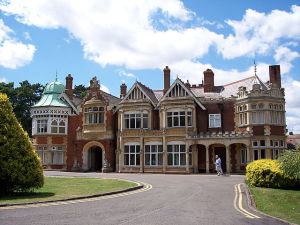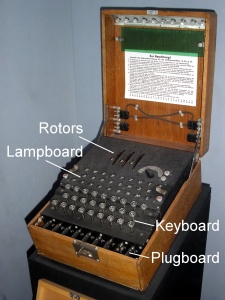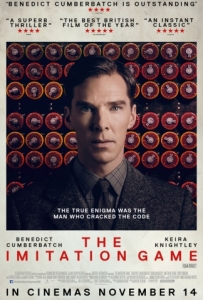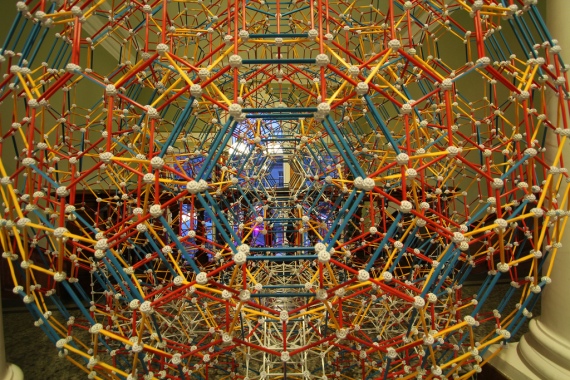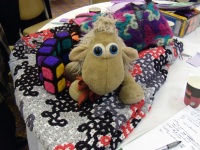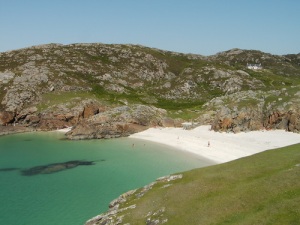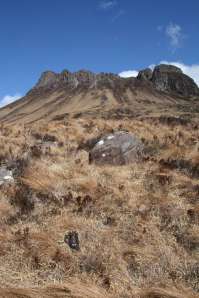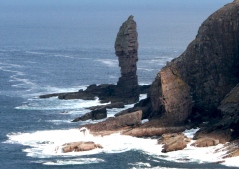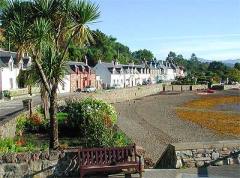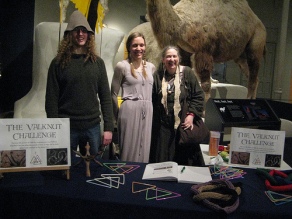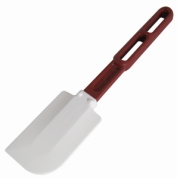In The Imitation Game: Part 2 we looked at Alan Turing’s work doing codebreaking at Bletchley Park during World War 2. In this final instalment of blog posts about the film The Imitation Game, we look at the work Turing did during the final years of his life, about pattern formation. This is based on a talk given by Professor Jamie Davies from the University of Edinburgh at an event called The Maths of the Imitation Game at the Filmhouse cinema.
You might be fooled into thinking that the film doesn’t touch on Turing’s work after Bletchley at all, but you would be wrong. The reference is subtle, but it is there from the very first scene. The opening part of the film shows Turing in his house, clearing up mess from a burglary. On a table we see a pine cone; on the walls we see pictures of strange spirals of dots and curious pictures of starfish. These pictures are again present in the final, very moving, scenes of the film, when Turing is at home suffering from the effects of his enforced chemical castration. But what do these images tell us about the work that Turing did?

Count the number of spirals on a pinecone (first four shown here). You often find a Fibonacci number.
Count the number of petals in a daisy, or the number of spirals in a pinecone, or the spirals in the head of a sunflower. You will very often get a Fibonacci number: one that appears in the sequence 1,1,2,3,5,8,13,21,34,… In this sequence, you get the next number by adding up the previous two.
Turing claimed that the ubiquity of Fibonacci numbers in plant forms was not a coincidence, and wanted to show that such patterns could arise as the result of chemical reactions in the cells of the plant. In this view he was influenced by the book On Growth and Form by the Scottish mathematical biologist D’Arcy Wentworth Thompson.
In 1952 Turing wrote the paper “The chemical basis of morphogenesis” which was ground-breaking work in explaining how local chemical reactions could result in large-scale patterns. Fibonacci numbers in pine cones, stripes on a tiger, tentacle patterns on a starfish and hexagons in a fly’s eye were all predicted to be manifestations of the same type of chemical reaction. Today Turing’s idea is called a reaction-diffusion equation and is used in even more areas of science than just animal biology.

Haeckel‘s picture showing various sea anemones with their tentacles. If you look closely in the film you can spot this picture on the wall of Turing’s house.
The idea is that patterns are formed by the interplay between two types of chemical: one that activates growth (called the activator) and one that inhibits growth (called the inhibitor). Production of the activator stimulates further production of the activator, but also stimulates creation of the inhibitor. Imagine a ring of cells around an embryo. A particular cell might grow ever-so-slightly faster than its neighbours, resulting in more of the activator being produced and thus even further growth. At the same time, the cell is producing the inhibitor chemical, meaning that the growth of cells adjacent to it is stunted. However, cells that are far enough away are not affected by the inhibitor, and so will grow as normal. This results in a sort of wave-like pattern around the embryo, of particular cells growing at regular intervals. And this is exactly what causes the regular arms of a starfish or the tentacles of a sea-anemone.
Turing was not only the first to come up with these ideas, but the first to test them using computer simulations. Working at the University of Manchester in 1951, he had access to the world’s first commercially available general-purpose digital computer, the Ferrati Mark 1, and he immediately started programming it to explore the consequences of his equations. Working by hand his equations would never have been tractable to solve, but using a computer he could see that they were a great model for the physical phenomena he was trying to explain.
Sadly Turing’s work was far ahead of his time, too difficult to understand for biologists (even though he made a conscious effort to explain things well!), and was largely ignored by the scientific community for fifty years. It was only in the late 1990s that the work was picked up again and Turing’s paper rediscovered, and today reaction-diffusion models are considered fundamental to the study of pattern-formation. Prof. Jamie Davies’ current research in Edinburgh is testing Turing’s ideas by ‘programming’ real living cells to make patterns on command, and his lab has been able to replicate all the predictions made by Turing.
To conclude, I think it is a shame that the film portrays Turing as being this incredibly autistic and single-minded person, giving all his love to machines and algorithms instead of real people. In reality he was a warm and friendly individual who had strong friendships and relationships, and, moreover, he did some of his most important work into living things rather than cold machines.
I hope my series of blog posts have highlighted the amazing research that Turing did, which revolutionised computer science, mathematics and biology, not to mention the pivotal role he played in breaking Enigma during World War 2. Many thanks go to John Longley, Tom Leinster and Jamie Davies for providing the material on which these posts have been based, and to the Filmhouse cinema in Edinburgh for hosting our event explaining the Maths of the Imitation Game.
